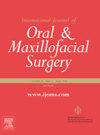Computed tomography-based findings and severity of temporomandibular joint osteoarthritis are associated with the development of skeletal mandibular retrusion
IF 2.2
3区 医学
Q2 DENTISTRY, ORAL SURGERY & MEDICINE
International journal of oral and maxillofacial surgery
Pub Date : 2025-01-24
DOI:10.1016/j.ijom.2025.01.003
引用次数: 0
Abstract
The aim of this study was to clarify the relationship between the severity of condylar osteoarthritis (OA) and skeletal mandibular retrusion. Three-dimensional cephalometric characteristics of skeletal mandibular retrusion were analysed using computed tomography scans from 15 patients with OA and 15 without OA. Mandibular, dental, and condylar-related factors were evaluated. Severity was scored by counting findings of cysts, erosion, atrophy, osteophytes, and sclerosis (score of 1 for the presence of each). The OA group was further divided into mild and moderate OA according to the total severity score of both condyles. The mean condylar volume was significantly lower in OA (851.1 mm3) than in non-OA (1151.3 mm3) (P < 0.001). A decrease in volume was significantly correlated with the number of radiographic OA findings (P = 0.012). Findings seen in mild OA were mostly cysts and erosion, while all findings were identified in moderate OA. The measured factors did not differ significantly between the mild OA and non-OA groups, whereas many mandible-related factors differed significantly between the moderate OA and non-OA groups. A significantly lower volume of the condyle was observed in moderate OA compared to non-OA (P < 0.001), suggesting that the appearance of atrophy, osteophytes, and sclerosis worsened OA from mild to moderate, and correspondingly, mandibular retrusion became apparent.
基于计算机断层扫描的结果和颞下颌关节骨性关节炎的严重程度与下颌骨后缩的发展有关。
本研究的目的是澄清尖锐骨关节炎(OA)的严重程度和下颌骨后缩之间的关系。本文分析了15例骨关节炎患者和15例非骨关节炎患者的三维头颅测量特征。评估下颌、牙齿和髁相关因素。通过计算囊肿、糜烂、萎缩、骨赘和硬化症的发现来对严重程度进行评分(每项评分为1分)。根据两髁的总严重程度评分将OA组进一步分为轻度和中度OA。骨性关节炎患者的平均髁突体积(851.1 mm3)明显低于非骨性关节炎患者(1151.3 mm3)
本文章由计算机程序翻译,如有差异,请以英文原文为准。
求助全文
约1分钟内获得全文
求助全文
来源期刊
CiteScore
5.10
自引率
4.20%
发文量
318
审稿时长
78 days
期刊介绍:
The International Journal of Oral & Maxillofacial Surgery is one of the leading journals in oral and maxillofacial surgery in the world. The Journal publishes papers of the highest scientific merit and widest possible scope on work in oral and maxillofacial surgery and supporting specialties.
The Journal is divided into sections, ensuring every aspect of oral and maxillofacial surgery is covered fully through a range of invited review articles, leading clinical and research articles, technical notes, abstracts, case reports and others. The sections include:
• Congenital and craniofacial deformities
• Orthognathic Surgery/Aesthetic facial surgery
• Trauma
• TMJ disorders
• Head and neck oncology
• Reconstructive surgery
• Implantology/Dentoalveolar surgery
• Clinical Pathology
• Oral Medicine
• Research and emerging technologies.

 求助内容:
求助内容: 应助结果提醒方式:
应助结果提醒方式:


